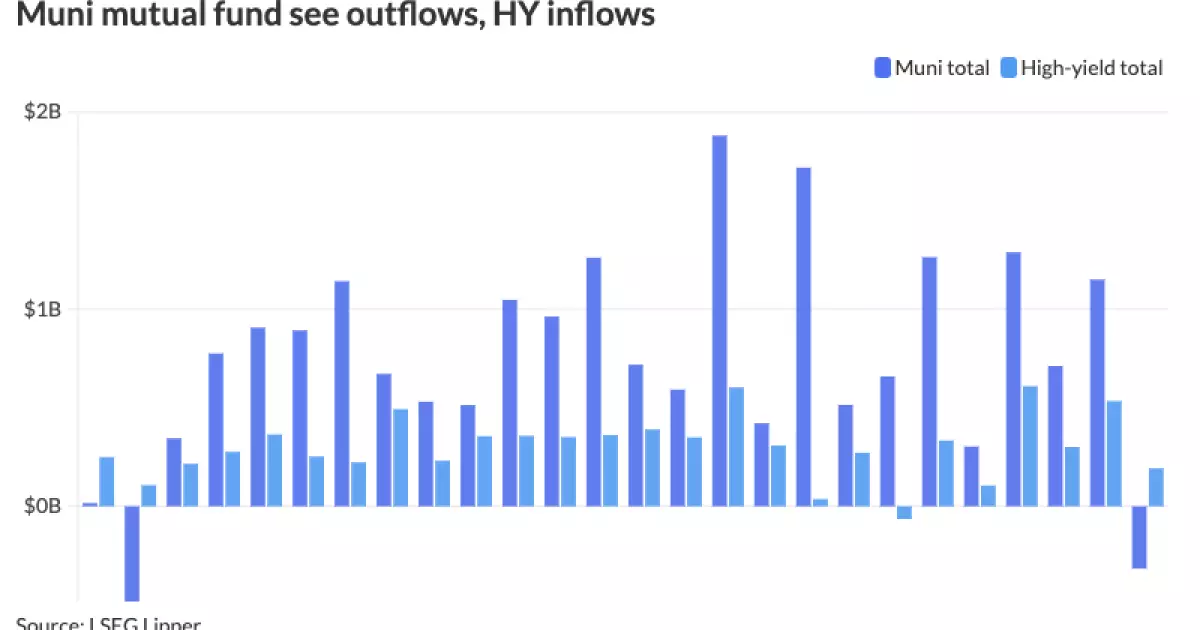In a notable shift within the municipal bond market, recent trends have highlighted a series of challenges. Over the past week, municipal bonds have faced significant losses, with Thursday marking a substantial downturn in the triple-A yield curves. This decline coincided with a noticeable slowdown in issuance and a marked outflow in muni mutual funds—an event that has not occurred since the summer months. This combination of factors signals a potential turning point in the market, prompting analysts and investors alike to reassess their positions and expectations.
The fluctuations in municipal bond yields are closely intertwined with changes in U.S. Treasury yields. As UST yields increased by four to seven basis points, municipals responded by cutting yields by two to ten basis points. This relationship emphasizes how sensitive the muni market is to broader economic conditions and interest rate movements. The recent outflow of $316.2 million from municipal mutual funds, as reported by LSEG Lipper, is particularly striking as it breaks a prolonged 23-week inflow streak. The previous week had recorded inflows of $1.15 billion, showcasing the volatility characterizing the current environment.
Mark Paris, Chief Investment Officer and head of municipals at Invesco, contextualizes these developments by underscoring the sensitivity of the municipal market to Treasury rate fluctuations. Even amidst recent Fed rate cuts, a pattern emerged where several consecutive days of negative treasury yields naturally led to reductions in municipal yield curves. Investor sentiment appears to be closely linked to these external pressures, and the reaction has seen municipal-to-UST ratios rising slightly, signaling a potential recalibration of risk and return expectations.
On Wednesday, the bond market witnessed a spike in bids, reaching a staggering $2.41 billion—the highest in over two years and double the average for 2024. This increase could be attributed to year-end positioning and cash requirements for recent deals. Kim Olsan, a senior fixed-income portfolio manager, indicated that these dynamics might create movement in the tight yield range previously experienced. The rise in money market yields has added further complexity, with daily floating rates surging by over 100 basis points.
Tax-exempt municipal money market funds also experienced a drain of $1.25 billion in the week ending December 9, demonstrating a broader trend of investors seeking alternative investments as yields become increasingly volatile. In contrast, taxable money markets saw an influx of $6.94 billion, reflecting a disparity in investor preferences and reactions to changing market conditions.
Despite recent setbacks, the outlook for municipal issuance in 2024 remains optimistic, with projections pointing towards record levels of issuance. While December is set to see limited supply following the anticipated $1.5 billion tax-exempt bond issuance by the New York City Transitional Finance Authority on December 17, the market is expected to rebound strongly in January. Analysts project issuance to hover around $500 billion in 2025, spurred by the urgency to capitalize on the current tax exemption landscape before potential legislative shifts.
The competitive nature of the market was recently illustrated with Massachusetts selling multiple series of consolidated loan bonds at competitive rates. The interest on these bonds suggests continued appetite for quality munis, despite the broader challenges faced in the current environment.
Recent data from various yield curves reveals a tightening of spreads across the municipal market. The MMD’s scale showed cuts of six to ten basis points, aligning closely with ICE Data Services‘ readings. The consistent downward adjustments emphasize how quickly market conditions can change and how essential it is for investors to stay informed about ongoing developments.
The resilience of municipal bonds amidst rising treasury rates poses questions for investors: as Treasury rates continue to fluctuate, will municipal-to-UST ratios stabilize around the low 80s? The answers to these questions will significantly shape investment strategies moving forward.
Ultimately, navigating the complexities of the municipal bond market requires vigilance and active management to capitalize on opportunities while mitigating risks in this unpredictable financial landscape.

